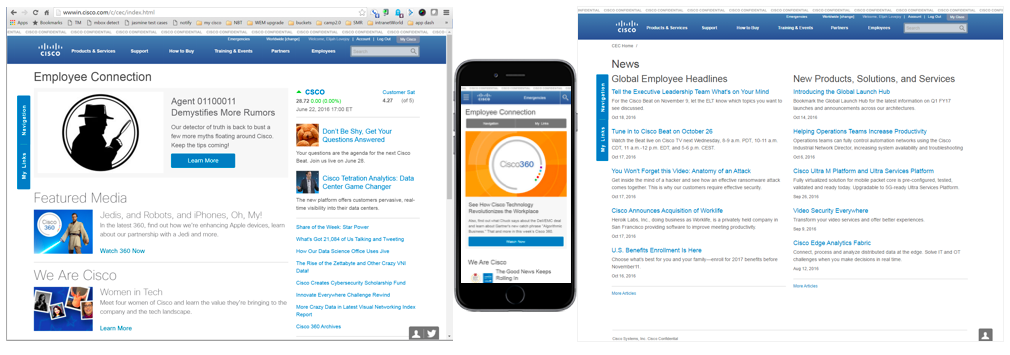What makes a great intranet one of the best?
In short, a lot. It requires a tremendous amount of intelligent work, planning, investment, and highly engaged executives and employees. But like an exceptional human being (insert your own election joke), none is perfect.
In fact, if you have a terrible intranet, in all likelihood, it will take years to fix (insert your own government joke). Intranet design, the user experience, is but one component.
Cisco has had one of the very best intranets for years. But as some there will openly tell you, it’s imperfect, and has been for years. Governance continues to be an issue; there is also the mobile dilemma. In presenting the Cisco digital workplace case study at the 2016 Digital Workplace and Intranet Global Forum conference, Cisco IT Architect Elijah Lovejoy shared many insights into the average Cisco employee, and their use of the intranet, via desktop, and mobile device.
A look at the Cisco populace is a fascinating look into the future of work — a future that is, in fact, the present in many organizations:
- 59% of employees work in different locations than their manager
- 50% are classified as mobile users
- 79% of staff work from home at least once per week

Now with all the hype about the mobile intranet, and bring-your-own-device (BYOD), you would think that mobile access of the intranet at Cisco would be huge… but you would be wrong. In fact, despite its massively tech savvy and nerdy population, direct mobile access of the main intranet is miniscule. Almost insignificant.
In September of this year, the intranet home page, the Cisco Employee Connection (CEC) received 3.7 million page views from 2.4 million visits. There were only 10,000 mobile visits. However, there were more intranet apps accessed than the main intranet itself. So, Cisco has started to see a decline in overall native site visits, but an increase in use via intranet specific apps. And Cisco now has several dozen intranet-specific apps.
“We act like a consumer company,” says IBM’s Reena Jana. “We’re not, but that’s how we treat content. We think like an editorial organization.”
IBM also has a great intranet, and it continues to adjust and improve in those areas it sees as weak. In fact, despite three significant redesigns of their home page in recent years, they’ve redesigned their home page, w3, yet again.
The old intranet design focused on search, and news; the new design is cleaner, responsive, mobile, and serves up a personalized, card-based approach.
“Cards: its how people navigate through the world (wide web),” says Reena Jana, Editor in Chief, Strategic Editorial & Creative Team at IBM. “We want to make it feel as personalized as possible. When you come in, its curated based on your habits and use.”

Personalization has become more de rigueur, once again. But so to has a consumer-based approach to design.
“We know we compete with consumer sites (for employee’s attention and time), so we act like a consumer company,” says Jana. Specifically, IBM created their new design, with a highly consumer-centric, almost marketing-based approach in mind:
- Knowing they’re competing for time and attention with other sites and apps on the devices IBMers use
- Understanding consumer-site/app best practices (create shorter, shareable, relevant, anticipatory experiences)
- Conducting user tests and adjust/optimize according to data and qualitative feedback
Content, and specifically content consistency, is also a significant challenge in an ecosystem of nearly 100 million pages and documents. To address this, IBM has created a global, cross-company editorial board, to discuss and apply content policy across the enterprise.
“We think like an editorial organization, says Jana. “My job is too look at the narrative experience at every level, and how it trickles up and down, to (and from) employee communications.”
The Editorial Council includes intranet editors along with global content marketers, sales, IBM Research staff, IBM.com homepage editors, thought leadership editors, social engagement leads, and people from off-domain platforms (“sometimes the traffic is high, and in the millions, so we invited them to the council,” adds Jana). The Council has created an international editorial calendar to compliment the online component, and provides international process guidance, and re-usable systems and templates for content publication. Jana and team also document and apply best practices from, you-guessed-it, consumer-based editors and publications such as The Harvard Business Review, NY Times, TED, etc.
“We act like a consumer company,” says Jana. “We’re not, but that’s how we treat content. We think like an editorial organization.”
Also Read: Digital Workplace or Intranet?

Pingback: Engaging staff, increasing intranet use | IntranetBlog.com - Intranet design, intranet news, intranet case studies, intranet redesign, intranet consultants